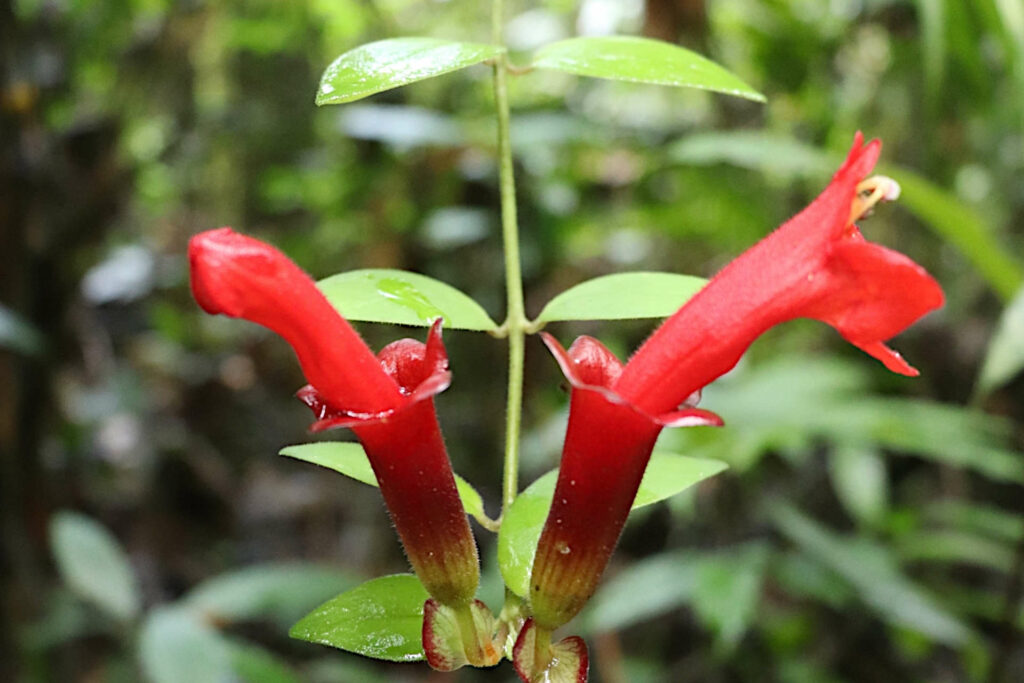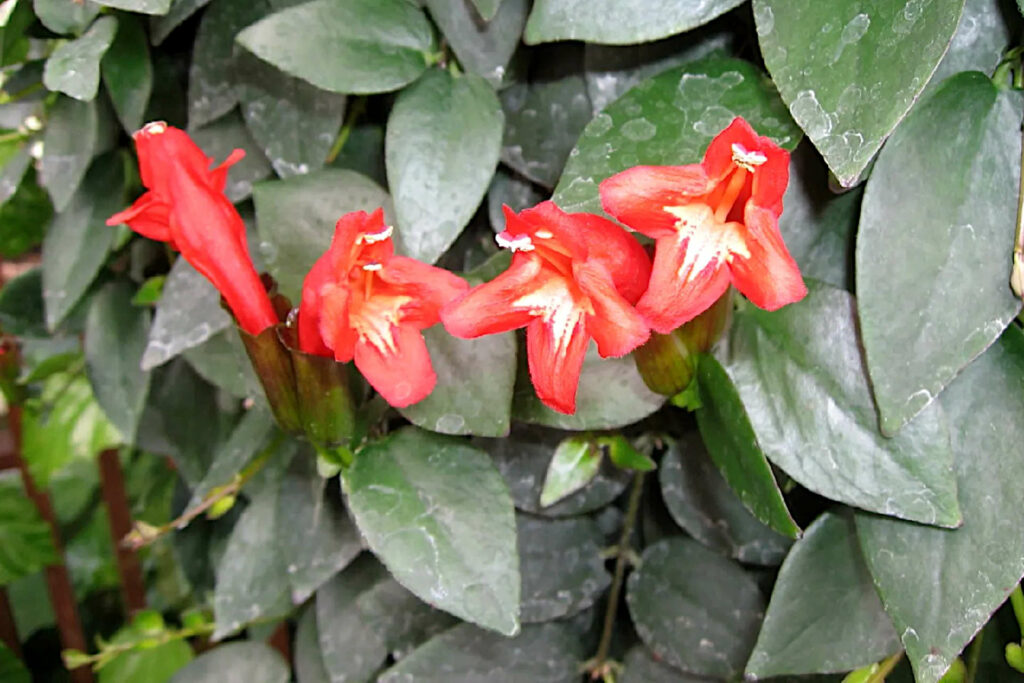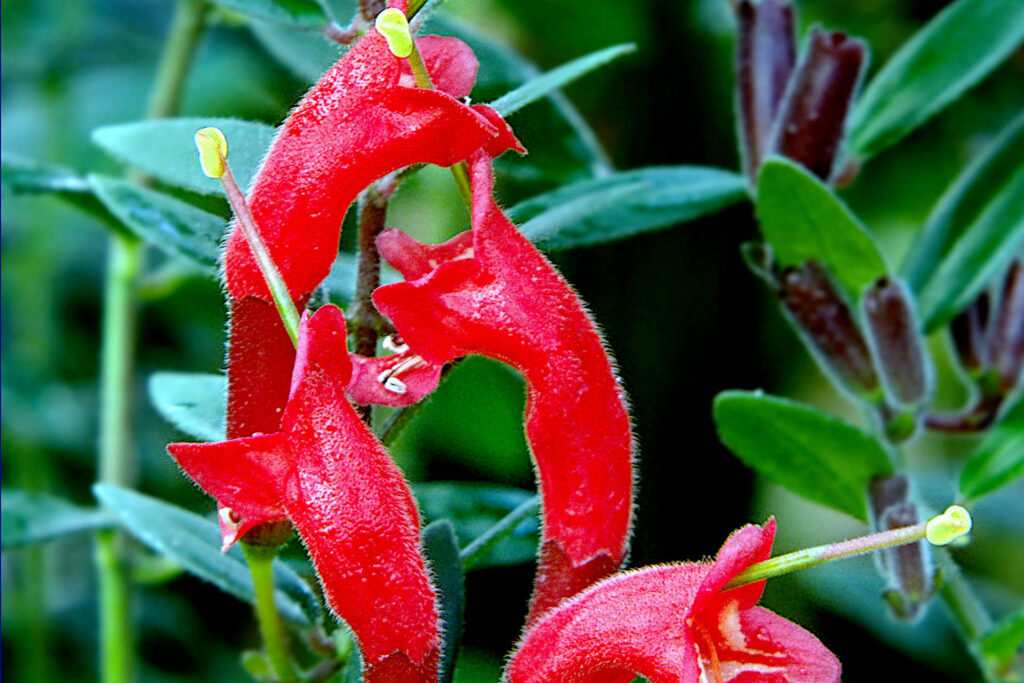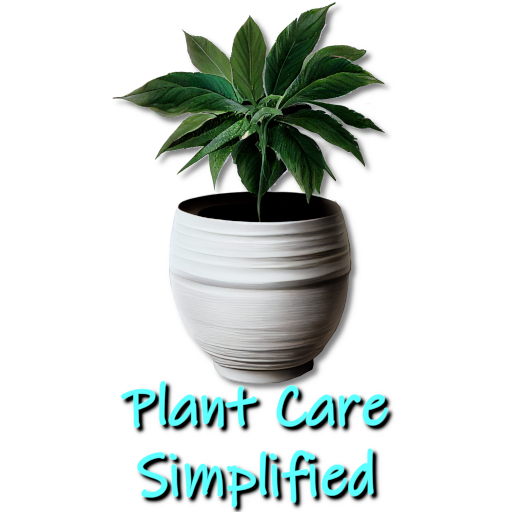Can a Lipstick Plant Go Outside
Kim is passionate about helping people create beautiful, healthy indoor spaces that are filled with plants. Kim believes that plants make us happier, healthier human...
The Lipstick Plant (Aeschynanthus radicans) is a visually striking houseplant known for its colorful blooms, so the question can a lipstick plant go outside in order to bring the same beauty to your garden is often asked. In short, a lipstick plant can go outside if the climatic conditions are right.
Understanding the plant's capabilities and ideal growing conditions is key to success, both indoors and potentially outdoors. Below, we will look at the various factors that affect whether a lipstick plant can go outside and how to manage the transition from indoor to outdoor.
Natural Habitat

The Lipstick Plant is an evergreen tropical plant native to Southeast Asia. It has elongated leaves and vivid red, lipstick-shaped flowers that give it its common name. Lipstick plants are epiphytes, meaning they grow on other plants and surfaces in tropical jungles rather than rooting in soil. They thrive in warm, humid environments with bright, filtered light.
Importance of Understanding the Plant's Outdoor Capabilities
While often grown as indoor container plants, some gardeners wonder if lipstick plants can be placed outdoors for the summer or grown in tropical outdoor gardens. Understanding the plant's light, temperature, water, and pest resilience will determine if moving it outdoors is possible. Key factors include sunlight needs, humidity preferences, and pest/disease resistance.
Benefits of Outdoor Placement for Lipstick Plants
Placing lipstick plants outdoors for the summer or growing them permanently in tropical gardens can provide several benefits compared to keeping them indoors year-round.
Enhanced Growth and Development
Exposure to natural outdoor conditions allows lipstick plants to experience optimal light levels, air circulation, humidity, and temperatures for growth. This can promote:
- Larger, bushier foliage
- Longer, more robust stems
- Bigger blooms
- Increased flowering
The tropical origins of lipstick plants make them well-suited for replicating outdoor growing environments, which satisfies their natural preferences.
Natural Sunlight and Fresh Air Exposure
Lipstick plants thrive in humid environments with abundant indirect sunlight or partial shade.
- The outdoor placement provides:
- Unfiltered exposure to the full spectrum of natural light
- Optimal sunlight conditions to maximize photosynthesis
- Improved air circulation and fresh air
- This natural light and air exposure can boost lipstick plant health and vitality.
Potential for Larger Blooms
The vibrant red, elongated flower spikes of lipstick plants are their most prized feature. Outdoor growth conditions can promote:
- Longer, sturdier flower stems
- Bigger, brighter blooms
- More pronounced lipstick-shaped flowers
Cooler night temperatures can also intensify flower colors.
Added Aesthetic Appeal to Outdoor Spaces
With proper tropical care, lipstick plants can enhance outdoor areas with their exotic, eye-catching flowers. Some possibilities include:
- Hanging baskets on porches or patios
- Accent plants in poolside containers
- Adding visual interest to tropical gardens
The cascading growth habit and colorful blooms of lipstick plants can elevate the ambiance of outdoor living areas.
Factors to Consider Before Moving Lipstick Plants Outdoors
While outdoor placement can benefit lipstick plants, certain environmental factors and lipstick plant care needs should be evaluated first to support healthy, successful growth.
Climate Compatibility
Lipstick plants are tropical epiphytes native to Southeast Asia and adapted to that climate. Important considerations include:
- Temperature
- Lipstick plants prefer consistently warm temperatures between 65-80°F (18-27°C).
- They can tolerate short periods down to 50°F (10°C) but sustained cooler temperatures can damage plants.
- Humidity
- Lipstick plants thrive in humidity levels of 60-80%.
- Lower humidity can cause the drying of leaves and flowers. Proper humidity is especially crucial during hot, dry periods.
- Hardiness Zone
- Most lipstick plants are only hardy in USDA zones 10-12, where frost is rare.
- Select cold-hardy varieties like A. radicans for zones 9b-11.
Sunlight Requirements
Lipstick plants need abundant filtered sunlight or partial shade. Important factors include:
- Sun Exposure
- Lipstick plants require 2-4 hours of direct sunlight daily.
- More than 4 hours of hot, direct sun can scorch leaves.
- East or west-facing exposures are ideal to provide gentle morning or afternoon sun.
- Partial Shade
- Dappled sunlight or partial shade is needed during the hottest parts of the day.
- Shaded southern exposures are suitable outdoor locations.
Temperature and Humidity Considerations
Lipstick plants require warm, humid conditions:
- Day Temperatures
- Prefer sustained temperatures between 75-85°F (24-29°C) during the day.
- Can experience stress below 65°F (18°C) or above 90°F (32°C).
- Night Temperatures
- Ideal night temperatures are 65-70°F (18-21°C).
- Do not allow below 60°F (15°C) for prolonged periods.
- Humidity
- Prefer constant humidity around 60-80% outside.
- Hot, dry air can require misting or pebble trays to boost moisture.
How do I protect my outdoor lipstick plants from pest infestations?
Lipstick plants face increased risks of pest problems when grown outdoors. Being proactive and vigilant about prevention is key to avoiding infestations.
Monitor Plants Frequently
- Check over plants thoroughly at least twice per week for early signs of pests:
- Specks of sticky honeydew
- Clusters of small insects
- Stippled, distorted or curling leaves
- Fine webbing
- Catching issues early before they spread is vital for quick control.
Quarantine and Isolate Infested Plants
If pests are detected, immediately move the affected plant away from other plants to contain the infestation.
Remove and Destroy Seriously Infested Foliage
Prune off badly infested leaves and stems and seal in a plastic bag for disposal to remove pest harborage.
Use Organic Insecticidal Soaps and Oils
Apply horticultural oil or insecticidal soap sprays to suffocate soft-bodied pests:
- Coat the undersides of leaves thoroughly
- Repeat every 5-7 days for 2-3 weeks
- Avoid applying during the hot midday sun
Use narrow-range oils to avoid plant damage.
Apply Targeted Organic Pesticides if Needed
For severe infestations, targeted organic pesticides may be required:
- Insecticidal soaps - Aphids, mites, thrips, whiteflies
- Neem oil - Broad spectrum pests
- Bacillus thuringiensis - Caterpillars
- Spinosad - Thrips, caterpillars, beetles
- Horticultural oil - Mealybugs, scale
Rotate different mode-of-action pesticides to prevent resistance.
Improve Air Circulation and Avoid Excess Moisture
- Improve airflow around plants through spacing and pruning.
- Water early in the day, so foliage dries by night to avoid diseases.
Introduce Beneficial Predators
Natural predators like ladybugs, lacewings, and predatory mites can control pests.
Be Prepared to Bring Plants Indoor if Problems Persist
Relocating plants inside for the season may be needed for severe infestations.
Steps for Properly Acclimating Lipstick Plants to the Outdoors

When transitioning lipstick plants outside for the first time, a proper acclimation process is vital to prevent shock. This involves gradually introducing the plant to outdoor conditions over 7-10 days.
Gradual Transition from Indoor to Outdoor Environment
- Start by placing the lipstick plant in a shady, sheltered outdoor location for just 1-2 hours.
- Slowly increase the time outside over a week, moving the plant into partial sun exposure.
- Avoid sudden changes in light levels, temperatures, or humidity.
- Check the plant's condition daily and watch for signs of stress like wilting.
- Adjust the duration outside accordingly if needed.
Monitoring and Adjusting Light Exposure
- Gradually transition the plant over 7-10 days to longer periods in partial sun or dappled shade.
- Start with just 1-2 hours of gentle morning sun per day.
- Slowly work up to the ideal of 2-4 hours of direct sun exposure daily.
- Monitor leaf color and move the plant if foliage shows signs of scorching.
Maintaining Optimal Moisture Levels
- Outdoor conditions demand more frequent watering than indoor environments.
- Check the soil daily, watering thoroughly when the top inch becomes dry.
- Increase watering during periods of heat, sun, or wind, which accelerate drying.
- Avoid wetting foliage excessively to prevent disease issues.
Protection from Extreme Weather Conditions
- Newly acclimated plants still need protection from temperature extremes or storms.
- Provide cover or bring plants back inside if frost, high winds, or heavy rain is expected.
- Move containerized plants to sheltered areas during severe weather events.
Potential Risks and Challenges of Outdoor Placement
While outdoor growth can benefit lipstick plants, it also comes with certain risks and difficulties to manage. Being aware of these potential issues can help gardeners prevent problems.
Vulnerability to Temperature Extremes
- Lipstick plants are tropical plants adapted to warm, stable conditions. Challenges can include:
- Cold Damage - Temperatures below 50°F (10°C) can injure plants. Frost is lethal.
- Heat Stress - High temperatures over 90°F (32°C) in full sun may scorch leaves or flowers.
- Temperature Fluctuations - Shifting day/night temperatures and cold fronts can shock plants.
- Solutions - Provide cover or heating for cold periods, shade during heat, and move plants indoors if concerned.
Increased Pest and Disease Risks
As we mentioned above, outdoor exposure raises chances of pest and disease problems that you need to be watchful for and monitor closely if you detect a problem to ensure your plant remains healthy.
Potential Damage from Natural Elements
Outdoor conditions pose hazards like:
- Wind Damage - Gale force winds can shred foliage and snap stems.
- Heavy Rain - Excess moisture promotes foliar diseases like leaf spots.
- Hail - Can cause wounds, damage stems, and destroy blooms.
- Solutions - Site plants in sheltered areas, stake/support plants, protect with covers as needed.
Limitations for Indoor-Only Cultivars
Some lipstick plant varieties intended for indoor use lack outdoor resilience:
- Low Light Tolerance - Scorching in direct sunlight.
- Susceptibility to Stress - Prone to wilting, leaf drop, and shock.
- Fewer Pest Defenses - Lack of natural compounds to deter pests.
- Unsuited for Cold - Lack of cold weather hardiness.
Solutions - Select vigorous outdoor types, and provide ample shade and wind protection.
Final Thoughts on Can a Lipstick Plant Go Outside
Relocating Lipstick Plants outdoors offers various benefits, including enhanced growth and striking aesthetics. However, it also comes with a number of challenges, such as climate considerations, pest management, and acclimation requirements.
Understanding these factors and choosing appropriate varieties can lead to successful outdoor cultivation. Regardless of the decision to move them outdoors or keep them indoors, providing optimal care and attention is essential for the health and vitality of the Lipstick Plant.
Commonly Asked Questions

Can all lipstick plants be placed outdoors?
Not necessarily. Purely indoor varieties lack outdoor hardiness. Seek hardy cultivars suitable for partial shade in your specific climate.
What is the ideal climate for outdoor placement?
Tropical or subtropical climates with warm temperatures, high humidity, and mild winters are best. Hardier varieties may tolerate cooler subtropics.
How can I protect my lipstick plant from pests outdoors?
Monitor closely, isolate infested plants, use horticultural oils/soaps or organic insecticides. Improve airflow and avoid excess moisture.
Can lipstick plants survive in colder regions?
In zones 9-11, hardy varieties may tolerate short frosts. Provide cover, warmth, and reduced water in winter. Indoor culture is easier in cold climates.
Are there any specific lipstick plant varieties recommended for outdoor placement?
There are varieties of lipstick plants, each with its own unique characteristics. Regardless of the variety, lipstick plants can grow equally well outdoors as they can indoors as long as it stays warm enough.
Resources
Hendrik Poorter: Pampered Inside, Pestered Outside? Differences and Similarities Between Plants Growing in Controlled Conditions and In the Field
Kim is passionate about helping people create beautiful, healthy indoor spaces that are filled with plants. Kim believes that plants make us happier, healthier human beings, and she loves sharing her knowledge with others so they can experience the joys of plant care for themselves. <a href="https://plantcaresimplified.com/kim-marson/">Read more</a>
More Posts